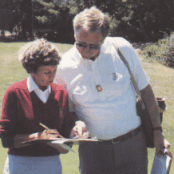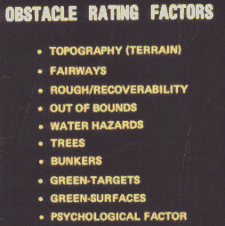|
Here Comes Your Slope Handicap...
About 10,000 American courses have now been rated
by the Slope method, so the USGA Slope Handicap System
becomes mandatory next year, effective March 1, 1991.
by GEORGE EBERL
IT IS UNLIKELY any game other than golf played on our planet by humans is subject to so much mathematics, finagling, and occasional machinations in the interest of equalizing competition. The process of handicapping is common in horse racing, of course, but horses aren't human � Flicka, Black Beauty, and Trigger notwithstanding � and among horses it is only a question of how much weight each must pack.
Among amateur players other than those who play at or near scratch and compete in national competitions where handicaps aren't factors, the very notion of handicap seems to have an aura, a mystique about it that may inspire lengthy clubhouse debates, discussions unfortunately shedding more darkness than light, It seems to go with the territory. Among some weekend warriors, that territory is uncharted terrain.
Arguably, they aren't to be blamed. Handicap procedures, combined with the Rules and Decisions of Golf, create layers of complexity and perplexity over the game that challenge the best and the brightest.
Dean Knuth, the USGA Director of Handicapping, has been involved indirectly and directly with the modern handicap procedure for the last dozen years, during which time it has reached a remarkable level of sophistication. For that matter, handicapping has quite a long, unusual history, and the requirement beginning March 1, 1991, that the USGA Slope System and Handicap Index must be used to carry the USGA Handicap trademark is merely the latest link in a long chain.

IN BRIEF, the USGA Slope System will be the only authorized USGA Handicap System. For approximately four years, a pre-Slope Handicap System has been optional, in large part because many courses had not yet been rated, so the use of Slope was oft.en impossible. It was a transition period.
Knuth said that about 10,000 courses have now been rated for Slope. Obstacles are principal factors in determining a course's Slope rating, which translates into its ease or difficulty. What happens is this: A team of four rates a course with a USGA Course Rating Guide (there is one for men and one for women), and when they've completed their hole-by-hole appraisal of obstacles, hazards, length, and even psychological factors (long scary tee shots over water, for example), the team captain totals the figures from their clipboards or notebooks.
Through a formula that has been worked out, this is converted into a Slope rating that is built around an average Slope rating of 113. Lower than 113 is easier; higher than 113 is tougher. Pine Valley is 152 and Pebble Beach 144, for example. That's tough.
Slope, as a term, is nothing mysterious; it was derived from the sloping line on a graph that mates the player handicaps across the bottom of the chart against the expected scores on the course for those at the various handicap levels (up the side of thc chart).
A scratch player would be tucked down in the lower left-hand corner of the graph; he would be expected to shoot to the course rating half the time. The 36-handicapper would be at the opposite end of the sloping line, with a much higher expected score than the scratch player.
USING the National Golf Foundation estimate of 13,000 courses in the United States, the 10,000 that have been rated so far means 3,000 courses have not been rated. Mitigating factors account for this; an estimated 1,500 executive courses and nine-hole short courses won't he rated, but they are part of the NGF count.
Some resort courses have not been rated, either; regional and state associations do the rating, Knuth explained, so courses that are not members of an association, and that have not requested a rating will be rated last. Their members will not be able to get USGA Handicaps.
Knuth said it is a problem; many of these unrated courses are privately owned daily-fee operations whose owners are inclined to ask, "What's in it for me?" He may answer his own question if he loses players because they can't have a legitimate handicap; what's-in-it-for-him may well be retention of some or many of his customers.
Oddly, the bulk of the remaining 1,500 or so unrated courses come from a half-dozen states � New York, Pennsylvania, Michigan, Missouri, Ohio, and Texas. Knuth said this can be traced to the private club character of these states' associations. Yet, this problem is being whipped, too, in New York and Pennsylvania, which Knuth described as success stories as teams are going out systematically to rate those that request it. Susan Tanto and Chick Wagner were moving forces in broadening the numbers of rated courses. In Pennsylvania, Ms. Tanto successfully pushed to create what is now the Keystone Public Golf Association to come to the aid of public courses.
THE EVOLUTION of handicapping has been a long and arduous process � perhaps much longer than many realize. Knuth said that R.A.L. Burnet, Historian of the Royal and Ancient Golf Club of St. Andrews, discovered a reference to handicapping in the Bet Books of the Honourable Company of Edinburgh Golfers on March 30, 1782, predating origins that are traced to the late 1800s, and to the Ladies Golf Union.
The term "handicap" is borrowed from the world of horse racing because it was popular to hold a drawing before a race in the 17th century and pull numbers from a hat � hand in cap � and this process somehow came to refer eventually to the practice of weighting horses to establish an equity.
Clearly, the principle could be applied in golf to equalize competition, but rather than loading the better player down with weights or tying rocks around his clubs, handicapping became a numbers game of giving or taking strokes. In the 1870s, clubs in England adopted the term handicap, and events featuring odds were played as handicap contests or tournaments.

Early handicap formulas favored the better players. In Knuth's view, "Today's formula provides greater equity for all levels of players." Arriving at that formula has been a project of the past dozen years, since the Handicap Research Team (HRT) was formed in 1978. Indeed, the handicapping section has grown in the USGA administrative headquarters, taking over much of the first floor of the five-year-old building in a section labeled GHIN � Golf Handicap Information Net.work. More than 975,000 handicaps from throughout the United States are recorded here on softly humming banks of computers for state golf associations.
ALTHOUGH THE WORD handicap was a comparatively late arrival on the golf scene, the concept was very much alive early. In the beginning, the act of allowing strokes in golf was called "assigning the odds," and that was done by the forerunner of our handicap chairman, who was called "Adjustor of the Odds."
Don't argue that Scots won't place a wager; betting at golf preceded feasting at the early clubs, and betting naturally led to creating some odds. Bets and odds were carefully entered into club Bet Books.
In the late 1700s, in Scotland, a wager transpired that matched one Scot hitting his ball against another throwing his. This bizarre match was halved. It is recorded on the books of the Honourable Company of Edinburgh Golfers. Shades of robber baron Jay Gould betting $1,000 on which raindrop would reach the bottom of the window first.
Golf course growth was relatively slow in the mid 1800s. In 1860, 36 courses were scattered about Great Britain, and over the next 10 years that grew to 58. But 20 years later, in 1890, the number had grown to 481, and that more than trebled to 1,571 by 1900, and jumped to 2,786 by 1909.
This growth was accompanied by the popularity of tournaments, and handicaps became an essential element. A handicap tournament at Westward Ho! received a good deal of publicity in Liverpool, and determination of handicaps was something of a novelty. The allowance given to each player was arranged in a full meeting, and each had a chance to object to the smallness of his handicap, either personally or by a representative, and "any difference of opinion was settled by the vote of all present. The nearness of the result demonstrates the advantage of settling handicaps by general consent, rather than leaving it to one or two (persons)."
Such things as maximum allowable handicap and the portability problem � carrying one's handicap from his home course to an unknown venue � were debated, and par came in for discussion as well. Key figures in these gestative days of the modern handicap were Miss Issette Pearson, of the Ladies Golf Union, Dr. Laidlaw Purves, and Henry Lamb, the latter two members of the Royal Wimbledon Golf Club.

It was Dr. Purves who set out the rules for universal handicapping, in 1898, at Wimbledon. They were the basis upon which the British Golf Union's Joint Advisory Council built its system of uniform handicapping (average of the best three scores over two years of medal scores).
Miss Pearson was instrumental in developing an early form of uniform course rating, assigning the first ratings to LGU member clubs. The LGU is given credit for establishing a national system of handicapping. In his A History of Golf, Robert Browning wrote, "...within eight or 10 years the LGU had done what the men had signally failed to do � establish a system of handicapping that was reasonably reliable from club to club."
The United States entered the scene when Leighton Calkins, later president of the Plainfield Country Club, in Plainfield, New Jersey, proposed adoption of the British system of averaging the best three scores for players within the Metropolitan Golf Association. It followed that he was appointed Handicap Chairman of the MGA.
The first USGA system was a modification of Calkins' system, which based scratch against par (the Massachusetts Golf Association at the time had employed bogey as its basis). Calkins proposed, too, that par ratings be based on the standard of ability of U.S. Amateur Champion Jerome Travers. The USGA accepted. Rating courses according to the expected score of the national amateur champion was accepted; course rating was born in America. (The USGA course rating continues to be based on the expected better-half score of the U.S. Amateur Championship.)
TODAY'S CIRCUMSTANCES were created from the work of the past dozen years or so since thc formation of the HRT. Its early years were spent conducting and analyzing surveys about club players, their performances, and even some demographic information. But the HRT knew the fundamental element in creating a better handicap was to improve the method of course rating, using more than mere length.
It was a massive undertaking; Knuth, known among colleagues as the Pope of Slope, spent many hours in airports traveling throughout the nation to associations from coast to coast, spreading the word and conducting course rating seminars using the new method. The 10,000 represent a piece of work. He admits it is possible another 1,000 will be rated by March 1, 1991, when Slope becomes mandatory. Now that Doug Sullivan, Knuth's assistant, is also living out of a suitcase, that additional 1,000 seems possible.
Clearly, the subjects of handicaps, handicapping, and rating courses have been with us a long time, and any of them will still stimulate lively debates in the clubhouses of our nation.
|




